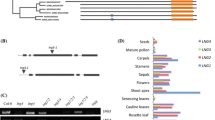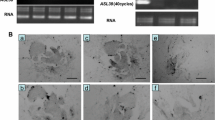Abstract
For genetic analysis of the mechanism of leaf curvature, we chose hyl1 mutant of Arabidopsis as a model for dissection of leaf venation pattern and adaxial/abaxial polarity. In leaves of hyl1 mutants that were hyponastic and curved upward, the complexity of the secondary veins was reduced, and the discontinuity of veins increased. In the lateral areas of the leaves where transverse curvature arises, dorsoventral polarity was lost due to the unclear spongy cells, and the epidermal cells became smaller on the adaxial surface than those of the abaxial surface, whereas the number of epidermal cells on the two surfaces were almost the same. In this case, less complexity of venation, decreased cell growth on the adaxial surface was attributed to leaf curvature. To depict the role of HYL1 in leaf venation and polarity, we constructed pHYL1:: GUS to drive the uidA (beta-glucuronidase) gene, and observed that the GUS signal appeared primarily in the petioles and mid-veins of rosette leaves, and were restricted to vascular tissues, demonstrating that HYL1 promoter directs the process of leaf venation by the uneven expression of the HYL1 gene in leaves. In situ hybridization indicates that HYL1 gene is preferentially expressed in leaf blades as well as vasculature. In curved leaves of hyl1 mutants, the expression level of adaxial identity gene REV was increased and the expression position restricted mainly in vasculature and on both sides of growing leaves near the margins while expression of the miR165 gene was remarkably reduced, suggesting that HYL1 maintain venation and polarity of growing leaves by altering the level of microRNA that direct the cleavage of REV transcripts.





Similar content being viewed by others
Abbreviations
- HYL1 :
-
Hyponastic leaves 1
- REV::
-
Revoluta
References
Berna G, Robles P, Micol JL (1999) A mutational analysis of leaf morphogenesis in Arabidopsis thaliana. Genetics 152:729–742
Candela H, Antonio ML, Micol JL (1999) Venation pattern formation in Arabidopsis thaliana vegetative leaves. Dev Biol 205:205–216
Carland FM, Berg BL, FitzGerald JN, Jinamornphongs S, Nelson T, Genetic BK (1999) Regulation of vascular tissue patterning in Arabidopsis . Plant Cell 11:2123–2137
Chen CB, Wang SP, Huang H (2000) LEUNIG has multiple functions in gynoecium development in Arabidopsis. Genesis 26:42–54
Chen Q, Atkinson A, Otsuga D, Christensen T, Reynolds L, Drews GN (1999) The Arabidopsis FILAMENTOUS FLOWER gene is required for flower formation. Development 126:2715–2726
Emery JF, Floyd SK, Alvarez J, Eshed Y, Hawker NP, Izhaki A, Baum SF, Bowman JL (2003) Radial patterning of Arabidopsis shoots by class III HD-ZIP and KANADI genes. Curr Biol 13:1768–74
Eshed Y, Baum SF, Perea LV, Bowman JL (2001) Establishment of polarity in lateral organs of plants. Curr Biol 11:1251–1260
Goodrich J, Puangsomlee P, Martin M, Long D, Meyerowitz EM, Coupland G (1997) A polycomb-group gene regulates homeoticgene expression in Arabidopsis. Nature 386:44–51
Han MH, Goud S, Song L, Fedoroff NV (2004) The Arabidopsis double-stranded RNA-binding protein HYL1 plays a role in microRNA-mediated gene regulation. Proc Natl Acad Sci USA 101:1093–1098
Hay JO, Moulia B, Lane B, Freeling M, Silk WK (2000) Biomechanical analysis of the Rolled (RLD) leaf phenotype of maize. Am J Bot 87:625–633
Jackson DP (1991) In: Bowles DJ, Gurr, SJ , McPherson M (eds) Molecular plant pathology: a practical approach. Oxford University Press, Oxford ,pp 163–174
Juarez MT, Kui JS, Thomas J, Heller BA, Timmermans MC (2004) microRNA-mediated repression of rolled leaf1 specifies maize leaf polarity. Nature 428:84–88
Kerstetter RA, Bollman K, Taylor RA, Bomblies K, Poethlg RS (2001) KANADI regulates organ polarity in Arabidopsis. Nature 411:706–709
Lu C, Fedoroff NV (2000) A mutation in the Arabidopsis HYL1 gene encoding a dsRNA binding protein affects responses to abscisic acid, auxin, and cytokinin. Plant Cell 12:2351–2365
Lu C, Han MH, Guevara-Garcia A, Fedoroff NV (2002) Mitogen-activated protein kinase signaling in post germination arrest of development by abscisic acid. Proc Natl Acad Sci USA 99:15812–15817
McConnell JR, Emery J, Eshed Y, Bao N, Bowman J, Barton MK (2001) Role of PHABULOSA and PHAVOLUTA in determining radial patterning in shoots. Nature 411:709–713
McConnell R, Barton MK (1998) Leaf polarity and meristem formation in Arabidopsis. Development 125:2935–2942
Nath U, Crawford BCW, Carpenter R, Coen E (2003) Genetic control of surface curvature. Science 299:1404–1407
Nelson T, Dengler N (1997) Leaf vascular pattern formation. Plant Cell 9:1121–1135
Otsuga D, DeGuzman B, Prigge MJ, Drews GN, Clark SE (2001) REVOLUTA regulates meristem initiation at lateral positions. Plant J 25:223–236
Pozzi C, Rossini L, Agosti F (2001) Patterns and symmetries in leaf development. Semin Cell Dev Biol 12:363–372
Reinhart BJ, Weinstein EG, Rhoades MW, Bartel B, Bartel DP (2002) MicroRNAs in plants. Genes Dev 16:1616–1626
Rhoades MW, Reinhart BJ, Lim LP, Burge CB, Bartel B, Bartel DP (2002) Prediction of plant microRNA targets. Cell 110:513–520
Sawa S, Watanabe K, Goto K, Liu YG, Shibata D, Kanaya E, Morita EH, Okada K (1999) FILAMENTOUS FLOWER, a meristem and organ identity gene of Arabidopsis, encodes a protein with a zinc finger and HMG-related domains. Genes Dev 13:1079–1088
Semiarti E, Ueno Y, Tsukaya H, Iwakawa H, Machida C, Machida Y (2001) The ASYMMETRIC LEAVES2gene of Arabidopsis thaliana regulates formation of a symmetric lamina, establishment of venation and repression of meristem-related homeobox genes in leaves. Development 128:1771–1783
Serrano-Cartagena J, Candela H, Robles P, Ponce MR, Perez-Perez JM, Piqueras P, Micol JL (2000) Genetic analysis of incurvata mutants reveals three independent genetic operations at work in Arabidopsis leaf morphogenesis. Genetics 156:1363–77
Talbert P, Adler HT, Parks DW, Comai L (1995) The REVOLUTA gene is necessary for apical meristem development and for limiting cell divisions in the leaves and stems of Arabidopsis thaliana . Development 121:2723–2735
Tang G, Reinhart BJ, Bartel DP, Zamore PD (2003) A biochemical framework for RNA silencing in plants. Genes Dev 17:49–63
Vaucheret H, Vazquez F, Crete P, Barte DP (2004) The action of ARGONAUTE1 in the miRNA pathway and its regulation by the miRNA path way are crucial for plant development. Genes Dev 18:1187–1197
Vazquez F, Gasciolli V, Crete P, Vaucheret H (2004) The nuclear dsRNA binding protein HYL1 is required for microRNA accumulation and plant development, but not posttranscriptional transgene silencing. Curr Biol 14:346–351
Vazquez F, Vaucheret H, Rajagopalan R, Lepers C, Gasciolli V, Mallory AC, Hilbert JL, Bartel DP, Crete P (2004) Endogenous trans-Acting siRNAs Regulate the Accumulation of Arabidopsis mRNAs. Mol Cell 16:69–79
Waites R, Hudson A (1995) phantastica: a gene required for dorsoventrality of leaves in Antirrhinum majus. Development 121:2143–2154
Yu XH, Peng JS, Feng XZ, Yang SX, Zheng ZR, Tang XR, Shen RJ, Liu PL, He YK (2000) Cloning and structural and expressional characterization of BcpLH gene preferentially expressed in folding leaf of Chinese cabbage. Sci China C 43:321–329
Acknowledgements
The author would like to thank Dr. Fedoroff for providing the seeds of hyl1 mutants and Mao Jian-ping for technical assistance in SEM. This work was supported by grants from the Natural Science Foundation of China (Grant No.39870450).
Author information
Authors and Affiliations
Corresponding author
Rights and permissions
About this article
Cite this article
Yu, L., Yu, X., Shen, R. et al. HYL1 gene maintains venation and polarity of leaves. Planta 221, 231–242 (2005). https://doi.org/10.1007/s00425-004-1439-7
Received:
Accepted:
Published:
Issue Date:
DOI: https://doi.org/10.1007/s00425-004-1439-7




